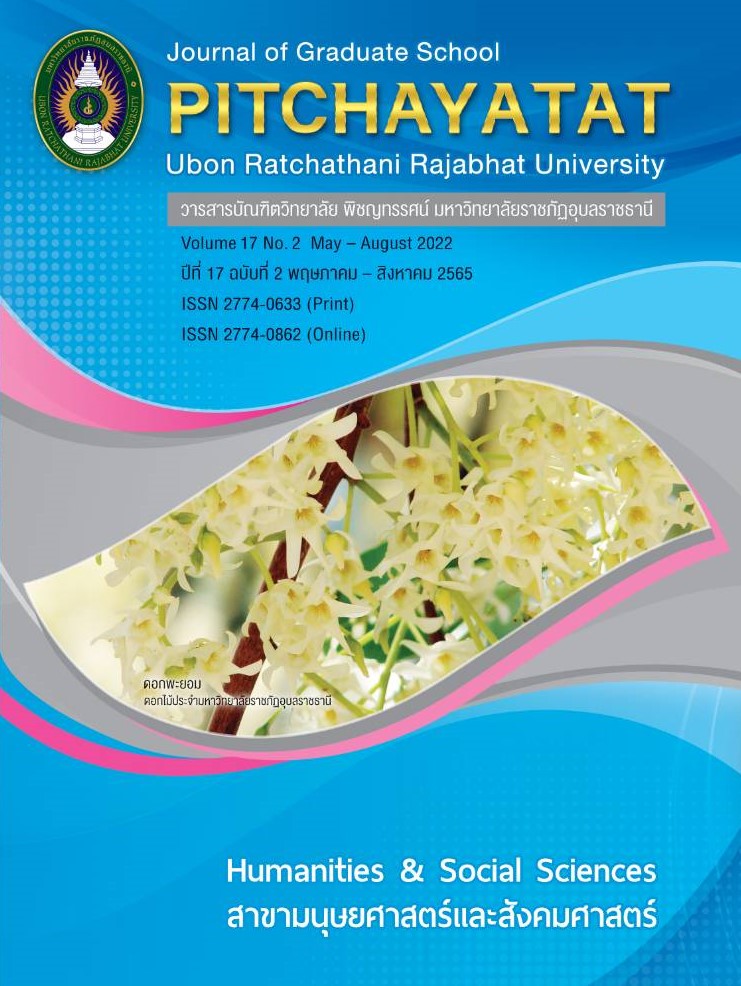การพัฒนาทักษะสมอง (EF) ด้านทักษะการปฏิบัติตน โดยใช้กิจกรรมศิลปะประดิษฐ์จากวัสดุเหลือใช้ ผ่านกระบวนการจัดการเรียนรู้แบบบูรณาการโดยใช้ปัญหาเป็นฐาน ของนักเรียนชั้นอนุบาลปีที่ 3 โรงเรียนบ้านประทาย
คำสำคัญ:
ทักษะสมอง (EF) , ศิลปะประดิษฐ์จากวัสดุเหลือใช้ , กระบวนการจัดการเรียนรู้ปัญหาเป็นฐานบทคัดย่อ
การวิจัยนี้มีวัตถุประสงค์เพื่อ 1) พัฒนาทักษะสมอง (EF) ของเด็กปฐมวัย โดยใช้กิจกรรมศิลปะประดิษฐ์จากวัสดุเหลือใช้ ผ่านกระบวนการจัดการเรียนรู้แบบบูรณาการโดยใช้ปัญหาเป็นฐาน 2) เปรียบเทียบทักษะสมอง (EF) ของเด็กปฐมวัยก่อนและหลังการจัดกิจกรรมศิลปะประดิษฐ์จากวัสดุเหลือใช้ ผ่านกระบวนการจัดการเรียนรู้แบบบูรณาการโดยใช้ปัญหาเป็นฐาน กลุ่มตัวอย่างที่ใช้ในการวิจัยครั้งนี้ เป็นเด็กปฐมวัย ชาย–หญิง อายุระหว่าง 5-6 ปี ที่กำลังศึกษาอยู่ระดับชั้นอนุบาลปีที่ 3 โรงเรียนบ้านปะทาย ตำบลทุ่งใหญ่ อำเภอกันทรลักษ์ จังหวัดศรีสะเกษ ภาคเรียนที่ 2 ปีการศึกษา 2564 จำนวน 13 คน ได้มาโดยการสุ่มแบบง่าย ผู้วิจัยดำเนินการทดลองใช้ระยะเวลาจำนวน 8 สัปดาห์ สัปดาห์ละ 3 วัน วันละ 60 นาที รวมระยะเวลาทั้งสิ้น 24 ครั้ง เครื่องมือที่ใช้ในการวิจัย ได้แก่ 1) แผนการจัดกิจกรรมศิลปะประดิษฐ์จากวัสดุเหลือใช้ผ่านกระบวนการจัดการเรียนรู้แบบบูรณาการโดยใช้ปัญหาเป็นฐาน 2) แบบสังเกตพฤติกรรมทักษะสมอง EF ของเด็กปฐมวัย (วัย 3-6 ปี) ตามแนวทางการจัดประสบการณ์ใน EF Guideline ในการวิจัยครั้งนี้ใช้แผนการวิจัยแบบ แผนการวัดเป็นระยะ และวิเคราะห์ข้อมูลโดยใช้ค่าเฉลี่ย ส่วนเบี่ยงเบนมาตรฐาน และการทดสอบที
ผลการวิจัยพบว่า
- เด็กปฐมวัยที่ได้รับการจัดกิจกรรมศิลปะประดิษฐ์จากวัสดุเหลือใช้ ผ่านกระบวนการจัดการเรียนรู้แบบบูรณาการโดยใช้ปัญหาเป็นฐาน มีพัฒนาการทักษะสมองสูงขึ้น
- ทักษะสมอง (EF) ของเด็กปฐมวัยที่ได้รับการจัดกิจกรรมศิลปะประดิษฐ์จากวัสดุเหลือใช้ ผ่านกระบวนการจัดการเรียนรู้แบบบูรณาการโดยใช้ปัญหาเป็นฐาน หลังการจัดกิจกรรมสูงกว่าก่อนการจัดกิจกรรม อย่างมีนัยสำคัญทางสถิติ ที่ระดับ .05
เอกสารอ้างอิง
ณัชชา เตชะอาภรณ์ชัย. ผลการจัดกิจกรรมการเคลื่อนไหวประกอบบทเพลงพื้นเมืองสำหรับเด็กปฐมวัยที่มีต่อความเข้าใจจังหวะ. กรุงเทพฯ: สำนักพิมพ์แห่งจุฬาลงกรณ์มหาวิทยาลัย, 2558.
ทิศนา แขมมณี. ศาสตร์การสอน: องค์ความรู้เพื่อการจัดกระบวนการเรียนรู้ที่มีประสิทธิภาพ. พิมพ์ครั้งที่ 17. กรุงเทพฯ: สำนักพิมพ์แห่งจุฬาลงกรณ์มหาวิทยาลัย, 2556.
บุญเชิด ภิญโญอนันตพงษ์. การประเมินการเรียนรู้ที่เน้นผู้เรียนเป็นสำคัญ แนวคิด และวิธีการ. พิมพ์ครั้งที่ 2. กรุงเทพฯ: วัฒนาพานิช, 2545.
บุญชุม ศรีสะอาด. การวิจัยเบื้องต้น. พิมพ์ครั้งที่ 7. กรุงเทพฯ: สุวีริยาสาส์น, 2545.
ไพศาล สุวรรณน้อย. Problem-based Learning : PBL. ขอนแก่น: คลังนานาวิทยา, 2558
สุภาวดี หาญเมธี และคณะ. พัฒนาทักษะสมอง EF ด้วยการอ่าน. กรุงเทพฯ: รักลูกบุ๊คส์, 2559
Caine, R. N. et al. 12 brain/mind learning Principles in action: Developing executive functions of
the human brain. 2nd ed. London: Corwin Press, 2009.
Heckman. “The Technology of Skill Formation,” American Economic Review. 97, 2 (May 2007): 31-47.
ดาวน์โหลด
เผยแพร่แล้ว
รูปแบบการอ้างอิง
ฉบับ
ประเภทบทความ
สัญญาอนุญาต
ลิขสิทธิ์ (c) 2022 วารสารบัณฑิตวิทยาลัย พิชญทรรศน์ มหาวิทยาลัยราชภัฏอุบลราชธานี

อนุญาตภายใต้เงื่อนไข Creative Commons Attribution-NonCommercial-NoDerivatives 4.0 International License.
บทความทุกเรื่องได้รับการตรวจความถูกต้องทางวิชาการโดยผู้ทรงคุณวุฒิภายนอกอย่างน้อย 2 คน ความคิดเห็นในวารสารบัณฑิตวิทยาลัย พิชญทรรศน์ มหาวิทยาลัยราชภัฏอุบลราชธานี เป็นความคิดเห็นของผู้เขียนมิใช่ความคิดเห็นของผู้จัดทำ จึงมิใช่ ความรับผิดชอบของบัณฑิตวิทยาลัย มหาวิทยาลัยราชภัฏอุบลราชธานี และบทความในวารสารบัณฑิตวิทยาลัย พิชญทรรศน์ มหาวิทยาลัยราชภัฏอุบลราชธานี สงวนสิทธิ์ตามกฎหมายไทย การจะนำไปเผยแพร่ต้องได้รับอนุญาตเป็นลายลักษณ์อักษรจากกองบรรณาธิการ






